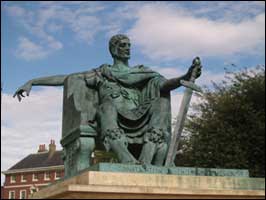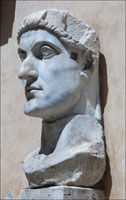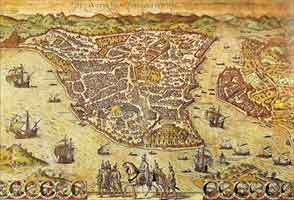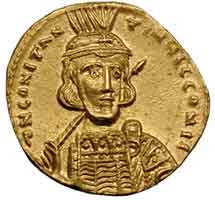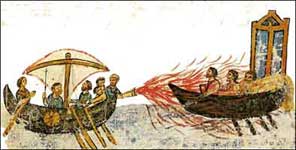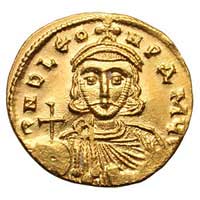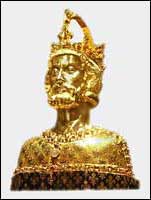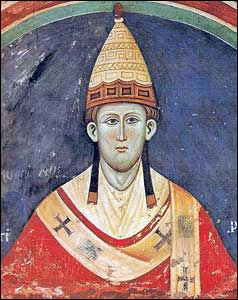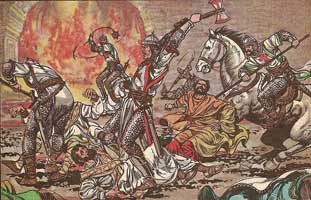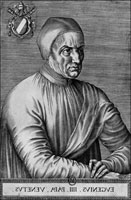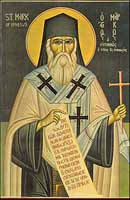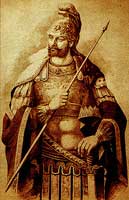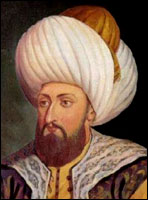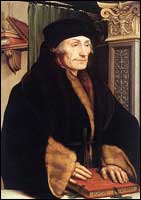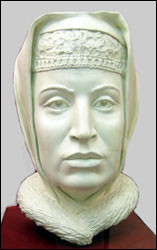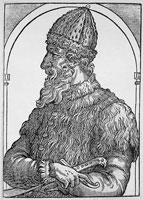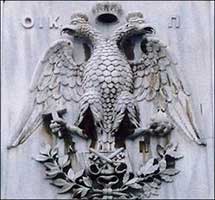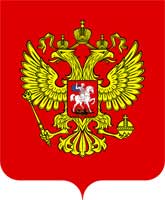Beside being a giant in stature, Jesus Constantine had a colossal ego because he named the new capital of the Roman Empire after himself.
|
In 324, he decided to build a new capital in the East at Byzantium, and leave Old Roma to the Papal dynasty.
After he became sole master of the Roman Empire, Constantine began building a new capital at a Greek city called Byzantium. Constantine had a monumental ego....Only 4 men in history have cities named after themselves: Alexander the Great, Constantine, Peter the Great, and George Washington!!
Naturally, Old Roma was not about to give pride of place to this new upstart so the rivalry and competition began almost immediately.
Islam was founded to overthrow Constantinople!!
Only 50 years after the founding of Islam by Mohammad, a huge Arab army . . . and NAVY . . . attacked Constantinople....Conquering Constantinople required a huge number of ships which you would not normally associate with desert dwellers.
|
A knowledge of combined operations by land and sea was necessary for the conquest of Constantinople. Also a knowledge of siegecraft and the use of battering rams and powerful catapults.
The first Muslim siege of Constantinople began in 674
It so happens that the first besiegers of Constantinople were DESERT DWELLING Arabs. The first siege began in 674 and lasted for 5 years.
Caliph Muawiyah I surrounded Constantiniople with a huge Arab army and navy. This was a miraculous accomplishment for desert dwelling Arabs.
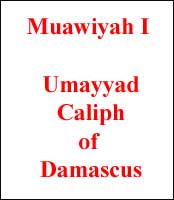 Muawiyah I (602–680) led the first Arab siege of Constantinople. |
|
Byzantine Emperor Constantine IV led the heroic defense of the city. The Arab secret weapon called Greek Fire. It was somewhat like napalm and actually burned on the water. It was the ancient world's equivalent of the atomic bomb.
The Eastern Romans had a secret weapon called Greek Fire. It was somewhat like napalm and actually burned on the water. It was the ancient world's equivalent of the atomic bomb.
|
The besiegers were barbecued with this Greek Fire: and the siege was a total failure, with thousands of Arab casualties:
The Saracen ships carried heavy siege engines and huge catapults; but the fortifications along the Marmara and the Golden Horn were proof against their assaults. The Byzantines, moreover, possessed a secret weapon. To this day we are uncertain of the composition of 'Greek fire'. Whether it was sprayed over an enemy vessel or poured into long, narrow cartridges and catapulted against its objective, the results were almost invariably catastrophic: the flaming, oil-based liquid floated upon the surface of the sea, frequently igniting the wooden hulls of the ships and causing an additional hazard to those who tried to jump overboard. For long the Muslims refused to admit defeat; only after the fifth year did the battered remnants of the Saracen fleet turn about and head for home. In 679 Muawiya sulkily accepted Constantine's offer of peace, which demanded the evacuation of the newly-conquered Aegean islands and an annual tribute. A year later he was dead. Constantine, on the other hand, was at the height of his popularity. He had inspired his subjects with the morale to withstand five years of siege by a power hitherto considered irresistible, and in doing so he had saved Western civilization. Had the Saracens captured Constantinople in the seventh century rather than the fifteenth, all Europe—and America—might be Muslim today. (Norwich, A Short History of Byzantium, p. 101.)
The siege turned out to be a total failure, with thousands of Arab casualties.
The second Muslim siege of Constantinople began in 717
The proud Arabs were very bitter about their failure to take Constantinople. The tried again in 717 with a new Caliph.
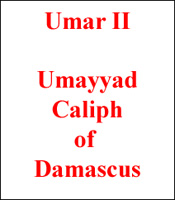 Caliph Umar ibn Abd al-Aziz (682–720). |
|
Roman Emperor Leo III led the heroic defense of the city:
For forty years the setback at Constantinople rankled with the Umayyad caliphs in Damascus. It remained inconceivable within Islamic theology that the whole of humankind would not, in time, either accept Islam or submit to Muslim rule. In 717 a second and even more determined attempt was made to overcome the obstacle that hindered the spread of the Faith into Europe. The Arab attack came at a time of turmoil within the empire. A new emperor, Leo III, had been crowned on March 25, 717; five months later he found an army of 80,000 men dug in the length of the land walls and a fleet of 1,800 ships controlling the straits. The Arabs had advanced their strategy from the previous siege. It was quickly realized by the Muslim general Maslama that the walls of the city were invulnerable to siege machines; this time there was to be a total blockade. The seriousness of his intentions was underlined by the fact that his army brought wheat seed with them. In the autumn of 717 they plowed the ground and planted a food supply outside the walls for harvesting the following spring. Then they settled down to wait. A foray by the Greek fire ships had some success but failed to break the stranglehold. Everything had been carefully planned to crush the infidels. (Crowley, 1453: The Holy War for Constantinople and the Clash of Islam and the West. p. 13).
It seems that all of JEHOVAH's creation was at war with the Muslims because on their way home an undersea volcano erupted and a storm destroyed most of the fleet.
Charlemagne–the phony "holy" Roman Emperor
Not a singe year went by but Old Roma sought to destroy her rival....The list of attackers included Persians, Arabs, Slavs, Bulgars, Magyars, Khazars, etc. etc; but all without success.
In the year 800 A.D., a golden opportunity presented itself to annex the Eastern Empire to Roma, and achieve by diplomacy what arms had failed to accomplish.
|
Charles the Great reigned as king of the Franks until December 25, 800 A.D. With the unmarried Empress Irene on the throne at Constantinople, the Pope quickly had Charles crowned "holy" Roman Emperor.
The next step was to propose a marriage between the two, thus annexing the Eastern Empire to Rome. The scheme failed miserably, and Irene was deposed and died in exile.
This unholy Roman "empire" was also called the First Reich. It was abolished by Napoleon Bonaparte in 1806.
The 4 crusades to conquer Constantinople
By the year 1000 A.D., Old Rome was getting desperate. All the attempts to conquer Constantinople by her mercenaries had ended in failure....Even the attempt to capture the Empire through marriage had failed.Beginning in 1069, Old Rome launched 4 massive Crusades to conquer Constantinople. All were failures except the last or Fourth Crusade.
1. |
First Crusade from 1095-1099. |
2. |
Second Crusade from 1147-1149. |
3. |
Third Crusade from 1187-1192. |
4.
|
Fourth Crusade from 1202-1204. |
The first three Crusades ended in failure, but the fourth and last established a short lived Latin Empire in Constantinople.
|
A rabble rousing monk named Peter the Hermit persuaded thousands of Europeans to join in a Crusade to "liberate" the Holy Land from the Arabs.
In August 1095, a huge undisciplined mob appeared outside the gates of Constantinople. Emperor Alexius was appalled. He kept a watchful eye on them and refused to allow them into the city . . . except in small groups. He quickly put them on ships and ferried them across the Bosporus:
Peter's rabble army was in no way typical of the armies of the First Crusade. Over the next nine months Alexius was to find himself the unwilling host to perhaps another 70,000 men, and a fair number of women, led by some of the most powerful feudal princes of the West. The economic, logistic, military and diplomatic challenges presented by this horde were unparalleled in Byzantine history, the basic problem being one of trust. Alexius was understandably skeptical about the high Christian motives so glibly professed. The Normans at least, as he well knew, were out for what they could get—if not the Empire itself, then their own independent principalities in the East. This latter objective did not worry him: a few Christian buffer states between himself and the Saracen might be no bad thing. But such principalities must not be founded on imperial territory and their princes must acknowledge him as their suzerain. Feudalism in Western Europe, he understood was based on solemn oaths of fealty; very well, he would demand just such an oath from all the Leaders in respect of any future conquests. (Norwich, A Short History of Byzantium, p. 257).
The next two Crusades were also total failures as far as conquering Constantinople was concerned, so we must concentrate on the fourth and last Crusade.
|
The Latin empire that was established by the Crusaders fell apart in 1261.
The Eastern Empire pulled further away from Old Rome after this brutal conquest and occupation by the Latins.
The Council of Florence in 1439
The Council of Florence, which ended on July 5, 1439, was the last great desperate effort by Old Rome to end the Great Schism before the conquest of Constantinople by the Turks.
The Council began in 1431 in Basel, Switzerland, and became known as the Council of Ferrara after its transfer to Ferrara was decreed by Pope Eugene IV. The Council transferred to Florence in 1439 because of the danger of plague at Ferrara, and because the city of Florence had agreed, against future payment, to finance the Council.
|
The Council was also the last great event before the Discovery of the New World by John Cabot and the Reformation. Old Rome used every weapon in her arsenal to get the Orthodox to sign the decrees reuniting the 2 churches.
All the Greeks present at the Councisigned the decrees of union–except for one man: Saint Mark of Ephesus.
For his uncompromising stand, Saint Mark died an untimely death at the young age of 52.
The voluntary union sought by Old Rome never materialized–so she unleashed her Muslim Turks against the city only 14 years later.
Constantinople finally fell to the Terrible Turks in 1453
Old Rome was finally able to eliminate her Eastern rival in 1453. After fighting heroically for 1000 years, the Empire finally came to an end.
|
The Orthodox church preserved the manuscripts of the Greek New Testament....The conquest of Constantinople by the Turks caused many of the Greek scholars to flee to Italy, bringing their manuscripts with them.
The Orthodox church preserved the Greek New Covenant manuscripts
The Orthodox church preserved the Greek New Covenant manuscripts that survived from the last great pagan persecution under Emperor Diocletian.
When Constantinople fell, many of the Greek scholars fled to Italy, bringing their priceless manuscripts with them. This was later to lead to the Renaissance and Reformation.
Venice–the adopted homeland of John Cabot–always had a very special relationship with the Eastern Roman Empire:
Northern Europe had taken an interest now, too, and its scholars had begun journeying to Italy, where many of them studied with the same Byzantine teachers as the Italians. The Dutch scholar who was the greatest of the northern humanists, Desiderius Erasmus, learned Greek in Venice with Marcus Musurus. Erasmus' English friend Thomas Linacre, a doctor and classicist who founded London's Royal College of Physicians, spent more than a decade in Italy studying Greek with Demetrius Chalcondyles and Politian, and winning his degree in medicine from the university of Padua. Linacre was Erasmus' and Sir Thomas More's doctor, and the close friend of another English humanist, John Colet, who had also studied in Italy. The German humanist Johannes Reuchlin had come to Italy in the 1480s, where he studied Greek with John Argyropoulos in Rome. (Wells, Sailing from Byzantium, p. 113).
The true name of the Messiah–Joshua of Nazareth–was changed in all the surviving Greek manuscripts.
|
Erasmus of Rotterdam was the intellectual giant of the Renaissance in Europe. He was the most learned man of his age. Every university in Europe vied for the honor of having him as a member of their faculty. He was also the editor of the Greek New Testament that Saint Martin Luther used to launch the blessed Reformation. It was said that "Erasmus laid the egg that Luther hatched." Erasmus had nothing but contempt for the corrupt clergy. His father and mother, Gerard and Margaret Brandt, are the subjects of The Cloister and the Hearth.
William Tyndale used the same Byzantine text as Saint Martin Luther in his superb English translation of the New Covenant.
Holy Russia was the successor of Constantinople!!
The Triune God, who sees all things in advance, had a new home for the Orthodox church in Russia.
|
Due to her family traditions, she encouraged imperial ideas in the mind of her husband, Ivan. It was through her influence that the ceremonious etiquette of Constantinople (along with the imperial double-headed eagle and all that it implied) was adopted by the court of Moscow.
|
We shouldn't fail to mention that the Julian calendar was imported to Moscow from Constantinople, as well as the Greek based Cyrillic alphabet.
Vital Links
Constantine's 6 Major Changes to Christianity.
The Vatican Against the Orthodox Church by Avro Manhattan
Crowley, Roger. 1453: The Holy War for Constantinople and the Clash of Islam and the West. Hyperion, New York, 2005.
Gibbon, Edward. The History of the Decline and Fall of the Roman Empire (in 6 volumes). Methuen & Co., London, 1909.
Gill, Rev. Joseph, S.J. The Council of Florence. Cambridge University Press. London, 1959.
Herrin Judith. Byzantium. The Surprising Life of a Medieval Empire. Princeton University Press, Princeton, NJ, 2008.
Meyendorff, John. Byzantium and the Rise of Russia. St. Vladimir's Seminary Press, Crestwood, New York, 1989.
Norwich, John Julius. A Short History of Byzantium. Alfred A. Knopf, New York, 1997.
Papadakis, Aristeides. The Christian East and the Rise of the Papacy. St. Vladimir's Seminary Press, Crestwood, New York, 1994.
Riley-Smith, Jonathan (Editor). The Oxford Illustrated History of the Crusades. Oxford University Press, New York, 1997.
Wells, Colin, Sailing From Byzantium. How a Lost Empire Shaped the World. Delacorte Press, New York, 2006.
Copyright © 2016 by Patrick Scrivener
